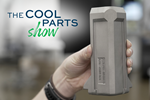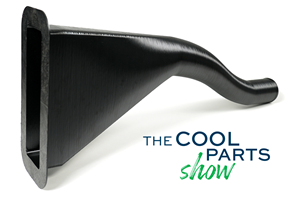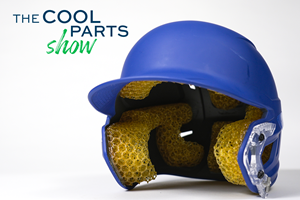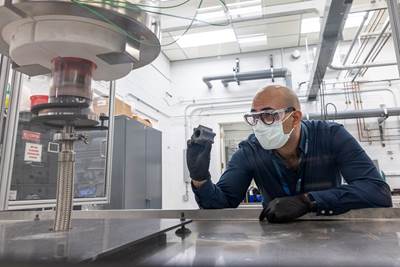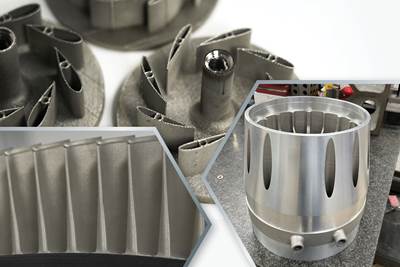Geothermal drilling is like oil and gas drilling, but deeper and hotter. Many of the needs are the same, but conditions such as operating temperatures around 400°F mean much of the oil and gas industry’s standard hardware won’t work and new solutions have to be found. In this episode of The Cool Parts Show, we look at an example: Downhole Emerging Technologies developed a device for temporarily plugging deep wells in geothermal drilling. The company’s Diamond Seal won a recent Department of Energy contest aimed at encouraging the technology innovation needed to advance geothermal power. The stainless steel component is made through laser powder bed fusion because the key to its operation is geometry enabling it to flex through the diameter change needed to travel down the hole, close it, and then travel out again.| This episode of The Cool Parts Show is sponsored by Carpenter Additive
The Cool Parts Show is a video series from Additive Manufacturing Media that explores the what, how and why of unusual 3D printed parts. Watch more here.
Have a cool part to share? Email us.
Related Resources
- Downhole Emerging Technologies
- The Department of Energy’s American-Made Geothermal Manufacturing Prize
- Additive manufacturing for oil and gas drilling
- Another alternative-energy cool part: Additive manufacturing for nuclear power
Transcript
Peter Zelinski
Quick note about the episode you're about to see. We're talking about a downhole device for deep wells. We will not be able to show you the inside side of the cool part. The inventor who you're going to meet wanted to keep that information secret. We're going to honor that request.
Stephanie Hendrixson
But we wanted to share this story anyway, in part because of the connection to geothermal energy. This is an example of how additive manufacturing is bringing new design possibilities, including some hidden designs and enabling things like different sources of power.
Peter Zelinski
Welcome to The Cool Parts Show.
Stephanie Hendrixson
Today on the show, we were looking at this part for geothermal energy, which uses a clever 3D printed geometry to allow for mechanical expansion and collapse.
Peter Zelinski
This is the Diamond Seal. It was created by a company that is applying oil and gas knowledge and expertise to the needs and challenges of geothermal power, which are the same but different. For example, the need to plug a hole for shaft repair. The way this is done in the oil and gas industry won't necessarily apply in a geothermal well, where the operating conditions are much more aggressive.
Stephanie Hendrixson
So let's talk about geothermal energy for a moment. This is energy from the Earth. Similar to oil and gas, you are drilling a well deep underground, but instead of extracting petroleum or some other substance, what you're after is the hot water or the steam that's coming up from these underground reservoirs. You can use that steam to drive a turbine, do various different things. And so, like you say Pete, oil and gas and geothermal have similarities in terms of the drilling technology, the downhole technology that's used. But geothermal is operating at much higher temperatures. And so in oil and gas, a plug like this could be made from plastic, could be made from rubber. But those materials aren't going to work for geothermal with these higher operating temperatures.
Peter Zelinski
So let's hear about that from the inventor of this part. Here is Ken Havlinek, CEO and co-founder of Downhole Emerging Technologies.
Ken Havlinek, Downhole Emerging Technologies
Geothermal power as it stands today is an untapped resource that we could start to develop. and the promise that it has for our country is in all fairness, in my opinion, it is the only green energy, clean energy that really, truly can meet our needs. But the challenge is, the rock that we need to drill into is extremely hot. It's in excess of 400°F, so the challenge is how do we take oil and gas know-how where we drill holes in the ground and we produce hydrocarbons on a daily basis. How do we use that technology but increase the temperature rating of all the technologies that do this, so that we can drill into the superheated rock?
Stephanie Hendrixson
So geothermal is something that the Department of Energy is interested in. They actually ran a contest challenging manufacturers to create geothermal equipment using additive manufacturing. Ken's company, Downhole Emerging Technologies, was one of the winners of that contest with this part.
Peter Zelinski
The contest was the American-Made Geothermal Challenge from the Department of Energy. The intent was encouraging technology development to help realize the promise of geothermal power.
Stephanie Hendrixson
And technology development specifically focused on additive manufacturing, which I think is interesting for this part because at the outset, Ken didn't know he was designing something that was ultimately going to be 3D printed.
Peter Zelinski
Right. He knew how he wanted to solve the problem. It's just that, he was limited in the geometry he was able to imagine, in part because he was limited by what he knew about the available manufacturing options.
Ken Havlinek, Downhole Emerging Technologies
When I start visualizing solutions to any problem, I'm always thinking, well, how am I going to make this? So, so for the first part of this project, the solutions that me and my team were coming up with were solutions that could be manufactured in a machine shop, because that's what we were visualizing. Our original design was not a bracelet shape. It was just a very large cylinder with a bulge in the middle. And when you compress it, the bulge increases. When you when you stretch it, the bulge decreases. Same invention, same concept, but just a really big cylinder. And we ended up putting grooves on the inside of this that were like strain relief grooves that improved the performance. But we couldn't figure out a way of making those grooves. It was just simply not machineable. And then we realized that additive manufacturing could print that entire part for us, no problem. Then somewhere in the middle of this whole program, quite frankly, I'll say eureka moment happened.
Peter Zelinski
So this is the form he got to enabled by additive manufacturing. This was produced by Proto Labs through laser powder bed fusion. We can't show you what's going on inside the part, like inside of these wall areas here, but how it works is this. So imagine this going down the hole on a mandrel that it travels along pre-stretched. Pre-stretched so that the inner diameter is a little bigger. The outer diameter is a little smaller. That provides the clearance to go down the hole to the point where it needs to operate, needs to plug the hole. When it gets to that point, deep in the hole, then it is compressed so that the inner diameter gets smaller, outer diameter gets bigger. These accordion ridges, like the ridges on the inside, press against the mandrel, the ridges on the outside press against the hole, and in that way it seals the hole, seals it in place. And that shape change, that diameter change between the pre-stretched and the compressed condition. The extent of that change is facilitated by geometry on the inside of this part that is possible because of additive manufacturing.
Ken Havlinek, Downhole Emerging Technologies
I truly believe that the eureka moment we had was because our brains were starting to get rewired a little bit, and suddenly we started visualizing new solutions to the same problem that now included additive manufacturing as a potential process that we could use, not just mills and lathes and molding. And once you start thinking about additive manufacturing capabilities and what they can do, suddenly you start thinking of new ideas. And rather than this very big cylinder that was, quite frankly, machined with just a couple of features that couldn't be machined, now all of a sudden we started thinking of things that couldn't be manufactured at all other than using additive manufacturing. And we came up with a solution for this problem that uses only stainless steel, basically no rubber, no plastic, only high temperature materials. And we were able to solve this problem where we can now seal in the super hot well using a device that's easily deployable and easily retrievable.
Stephanie Hendrixson
All right, I think we got this.
Peter Zelinski
This is the Diamond Seal. Its purpose is to plug a hole in a geothermal well. the same function is performed in oil and gas drilling, but the operating conditions are much more aggressive in geothermal power.
Stephanie Hendrixson
The seal was developed by Downhole Emerging Technologies. And initially they thought they were going to be able to machine the design that they had in mind, but then they learned about additive manufacturing, learned about the geometric possibilities. And ultimately, this seal was 3D printed by Proto Labs using laser powder, bed fusion.
Peter Zelinski
Additive manufacturing makes possible this accordian form that is aided by some geometry that is inside the part, and the result is that its dimensions can be changed significantly by pre stretching it first to get it down the hole, compressing it to expand the diameter so that it can plug the hole. And then it can be stretched again so it can be extracted from the hole after it's done. So that it doesn't have to be drilled away.
Related Content
8 Cool Parts From Formnext 2024: The Cool Parts Show #78
End-use parts found at Formnext this year address various aspects of additive's advance, notably AM winning on cost against established processes.
Read MorePreassembled Turbojet Engine, 3D Printed in One Build: The Cool Parts Show #75
Turbojet engines typically consist of hundreds or thousands of parts, but this engine — 2023 winner of The Cool Parts Showcase for Best Proof of Concept — was 3D printed as just two pieces, with the monolithic rotor embedded inside the stationary engine shell.
Read MoreAircraft Ducts 3D Printed in Composite Instead of Metal: The Cool Parts Show #68
Eaton’s new reinforced PEKK, tailored to aircraft applications, provides a cheaper and faster way to make ducts compared to formed aluminum.
Read More3D Printed Lattices Replace Foam for Customized Helmet Padding: The Cool Parts Show #62
“Digital materials” resulting from engineered flexible polymer structures made through additive manufacturing are tunable to the application and can be tailored to the head of the wearer.
Read MoreRead Next
Safer Nuclear Energy: 3D Printed Silicon Carbide Fuel Forms
Binder jetting provides a way to create pure silicon carbide fuel structures that can withstand the harsh environment of a nuclear reactor and provide a strong barrier against the release of radionuclides.
Read More3D Printed Brackets Secure Fuel for Nuclear Power: The Cool Parts Show #45
Can additive manufacturing improve the design of nuclear power plants? These steel brackets are the first step.
Read MoreIn Power Generation, the Changes From 3D Printing Will Be System-Wide
Additive manufacturing holds promise for various vital components of a gas turbine, and for greater output in hydro and nuclear power as well. Recent articles find many different advances from AM that will sum to transform the power generation sector.
Read More



